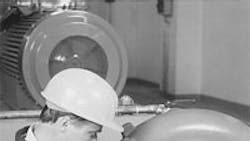Shock-pulse monitoring
Q: Recently, I heard someone mention “shock-pulse monitoring” as a method of diagnosing bearing problems. What is this?
A: Shock-pulse monitoring lets you detect a bearing in distress and fix the problem before it worsens and affects other components. As the rolling elements rotate, the balls or rollers create a shock pulse as they enter the load zone.
These shock pulses radiate from the bearing into the housing. The shock pulse energizes the transducer in a hand-held monitor, causing a reference mass to oscillate. This compresses a piezo-electric crystal, producing a voltage proportional to the shock pulse energy. The energy is affected by such factors as lubricant film thickness, bearing damage, temperature, and load.
Shock pulse transducers are tuned to operate at their resonant frequency of 32 kHz. They filter out machine vibration frequencies below this value because they are not bearing related. Thus, the transducer is sensitive to, and focused on the bearing.
Q: I’m familiar with vibration monitoring. How does shock-pulse monitoring differ?
A: Vibration analysis devices monitor overall machine conditions, and it is difficult to identify bearing responses because the bearing mass is so small compared to that of the machine. But a shock-pulse device analyzes parameters that relate exclusively to the bearing-lubrication status.
Shock-pulse monitors respond to the brief initial loaded contact between rolling surfaces before surface deformation takes place. This initial contact produces material acceleration that propagates ultrasonically as a compression wave or shock pulse. The magnitude of these shock pulses depends on the surface condition and the peripheral velocity of the bearing. The signals are very weak and can only be picked up by a specially- tuned transducer.
To put this in perspective, shock pulses produced by a bearing can increase by 1,000 times from when the bearing was in good condition to when it needs replacing.
The rolling-surface deformation causes a second impact stage, which produces vibration that can be detected by vibration-analysis monitors. However, bearing damage has to be severe before the signal it emits can be differentiated from other machine vibrations.
Q: To be safe, I relubricate the bearings in my plant very frequently. So, why do I need to monitor them?
A: I’ve heard this comment many times. Unnecessary downtime for routine maintenance and relubrication is expensive. By switching from preventive-maintenance to predictive-maintenance based on shock-pulse monitoring, it’s possible to extend the time between scheduled downtimes by a factor of six to eight.
Also, the information from shock-pulse monitoring helps avoid over-lubrication or lubrication with the wrong lubricant. Not only does this save on lubricant cost, but it also avoids the perils of high bearing temperatures resulting from over-lubrication.
Q: All this sounds rather complicated. How do I use this “shock-pulse” information?
A: The strength of the shock-pulse voltage signal is measured at a high and a low-level rate of occurrences. These rates, and the difference between them, determine the bearing’s condition. The high-level rate is affected primarily by bearing lubrication or misalignment. The low-level rate is affected mainly by imperfections — damage — in the bearing.
From these data, and information on bearing type and rotational speed, you can determine these conditions: a satisfactory- running bearing, a dry-running bearing, one that shows signs of deterioration, and one that is damaged. The severity of damage is also indicated, which helps in scheduling bearing replacement.
Continue on page 2
A reference value indicates the condition of lubrication between rolling elements, and can be used to schedule lubrication intervals and to determine if the proper lubricant type is being used.
Q: So, now I know I’ve got a bearing problem. What can I do?
A: Once you detect a dry-running or damaged bearing, the only way to possibly extend its life is through proper lubrication.
With an oil bath or sump-type of lubricant supply, drain the oil and flush the cavity with solvent to remove any sediment. Then refill with clean oil to the recommended level. With an oil-mist system, clean the ports before adjusting the number of drops or the pressure to allow more oil into the bearing.
With a grease-backed bearing, remove the grease reliefs before introducing clean grease.
